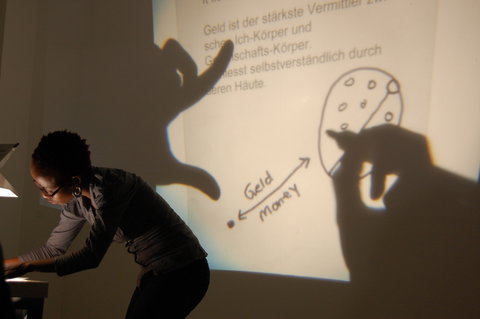
We conceptualise performance documentation in the following way: every instance of performance documentation is a translation into another medium and hence a transcription giving rise to artefacts. By performance documentation we understand the sum of all documentation materials; those which are used or produced in preparing a performance as well as materials and media used during a performance and all medial recordings created during the performance, which then make reception and transcription possible.
Where performance documentation is concerned, the question of the documentary, or the production of truth and knowledge, arises from a slightly different angle. The intention of creating a link with the live moment is of course inherent in performance documentation. The documents, as substitutes for the event, are supposed to provide evidence that the event actually took place. While performance theory worked against history writing for 30 years, concentrating entirely on presence and the live experience, emphasising its transience and discouraging any kind of documentation,[1] in the 1990s, the focus of discourse shifted from an ontological to a phenomenological dimension of providing evidence, on the premise that what appears in documents can provide realisation and knowledge. In brief, three developments brought about this change in viewpoints on performance documentation.
One of them was initiated by Amelia Jones, who in 1998 established that the performance event needs the photograph to confirm it happened at all.[2] According to Jones, performance only becomes a work through its documents. Under American copyright law, a work is only regarded as such if it is available as a copy. A live performance, which only exists for an audience at the moment of execution and is not recorded in any way in writing or by technological means, is not protected by copyright law and can hardly be claimed to be or defined as intellectual property.[3]
Philip Auslander postulates moreover that the documentation or documents themselves can sometimes be the event and not necessarily a testimonial. He is referring here to the fact that since the 1970s performances have been created especially for the camera without being preceded by a live performance before an audience.[4] Barbara Clausen underlines this by giving a number of examples of live performances which can only be received in their entirety in a mediatised form. She cites, for example, Peter Weibel’s subversive intervention “Polizei lügt” [police lie] in Vienna. The action is only intelligible from the photo taken of it,[5] showing Peter Weibel holding a sign bearing the word “lügt” [lie(s)]. He is holding it directly under the illuminated sign of a police station marked “POLIZEI” [police]. The photograph was deliberately taken from an angle which allows the subversive message to be read, which would otherwise remain obscure. “Weibel’s status as a performer is not proven until the documentation is received.”[6]
The third influence to be mentioned here is Rebecca Schneider’s work. She has determined that performance itself is a form of document, since cultural practices are transmitted through it. For example, in dance, historical codes are embodied and passed on in the form of a repertoire. By a document, she not only understands a stable item of value which is preserved but everything that encourages an action; which is, then, performative and embodies both the disappearance and appearance of something.[7] Taking these views into account, we can venture a new definition of documentation in the field of performance. According to Auslander, the priority is not to reconstruct the event as exactly as possible through documents but to make the performance accessible to a broader public through documents. If one assumes that performance produces realisation and documents produce a performance in the first place, this must influence how one works with the documents of performance art in terms of history, mediation and storage. A performance archive cannot, then, be a passive collection but should be the result of performative procedures and activities as well as the reflection of them.
[1] Here we refer to Peggy Phelan’s argument that performance is identified primarily by its disappearance. Cf. Phelan, Peggy, Unmarked. The Politics of Performance, Routledge, London 1993.
[2] Jones, Amelia, „Presence“ in: Absentia: Experiencing Performance as Documentation in: Art Journal, Vol. 56, No. 4, Performance Art: (Some) Theory and (Selected) Practice at the End of This Century, Winter 1997, pp. 11-18, published by: www.jstor.org
[3] Auslander, Philip, Liveness: Performance in a mediatized culture, Routledge London and New York 1999, p. 131-133.
[4] Auslander, Philip, „On the Performativity of Performance Documentation“, in: Barbara Clausen / Museum Moderner Kunst Stiftung Ludwig Wien (eds.), After the Act. The (Re)Presentation of Performance Art, Verlag für moderne Kunst, Nuremberg 2006, p. 27.
[5] Weibel, Peter, Polizei lügt, 1977, from the series “Offenes Werk”.
[6] Translated from the German: “Weibels Status als Performer wird erst in der Rezeption der Dokumentation bewiesen”, in: Clausen, Barbara, Dokumente zwischen Aktion und Betrachter“ in MAP – media / archive / performance, 1/2009, www.perfomap.de (downloaded on 3.5.10).
[7] Cf. Schneider, Rebecca, Performance Remains. Performance Research. 6.2 On Maps, Dartington, UK 2001, p. 100-108, www.routledge.com.